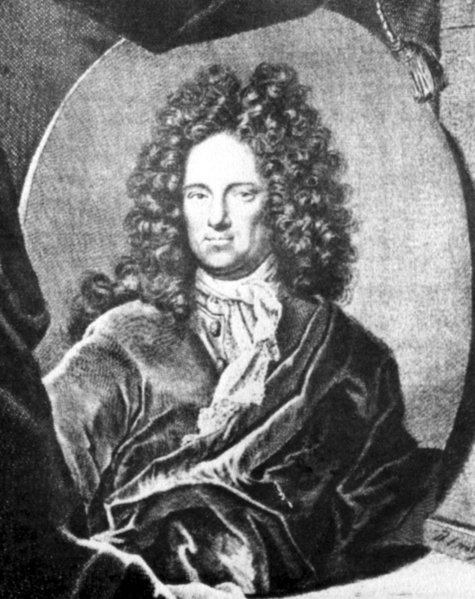<Back to Index>
- Mathematician, Physicist, Physician and Philosopher Ehrenfried Walther von Tschirnhaus, 1651
- Painter Alfred Leopold Isidor Kubin, 1877
- Jurist Hugo Grotius, 1583

Ehrenfried Walther von Tschirnhaus (or Tschirnhausen) (April 10, 1651 – October 11, 1708) was a German mathematician, physicist, physician and philosopher. He is the inventor of the European porcelain, an invention that for a long time had been assigned to Johann Friedrich Böttger. He was born in Kieslingswalde (now Sławnikowice in western Poland) and died in Dresden.
Tschirnhaus attended the Gymnasium at Görlitz. Thereafter he studied mathematics, philosophy, and medicine at the University of Leiden. During his travels he met Baruch de Spinoza and Christiaan Huygens in the Netherlands, Isaac Newton in England, and Gottfried Wilhelm Leibniz in Paris, with whom he maintained a life-long correspondence. He became a member of the Académie Royale des Sciences in Paris.
The Tschirnhaus transformation, by which he removed certain intermediate terms from a given algebraic equation, is well-known; it was published in the scientific journal Acta Eruditorum in 1683.
In 1682 he worked out the theory of catacaustics and showed that they were rectifiable. This was the second case in which the envelope of a moving line was determined. One of the catacaustics of a parabola is known as Tschirnhausen cubic.
Tschirnhaus produced various types of lenses and mirrors, some of them are displayed in museums.
His work Medicina mentis sive artis inveniendi praecepta generali (1687) combines methods of deduction with empiricism and shows him to be philosophically connected to the Enlightenment. After he returned home to Saxony, Tschirnhaus initiated systematic experiments, using mixtures of various silicates and earths at different temperatures to develop porcelain, which at that time was only available as a luxury import from China and Japan. Already in 1704 he showed “porcelan” to Leibniz’s secretary. He proposed to Frederick August II, Elector of Saxony, the establishment of a Porcelain Factory, but was denied. In 1704 he became the supervisor of Johann Friedrich Böttger, a 19 year-old alchemist who
claimed that he was able to make gold. Böttger only reluctantly
and under pressure started to participate in Tschirnhaus’ work by 1707.
The use of Kaolin from Schneeberg, Saxony, and alabaster advanced
the work, so that August II named him the director of the porcelain
factory he intended to establish. He ordered a payment of 2,561 thalers
to be made to Tschirnhaus, but the recipient requested to postpone the
payment until the factory was producing. Unexpectedly, Tschirnhaus died
on October 11, 1708. The project came to a halt. Three
days after Tschirnhaus’ death, there was a burglary at his house, and,
according to a report by Böttger, a small piece of porcelain was
stolen. This report suggests that Böttger himself recognized that
Tschirnhaus already knew how to make porcelain, a key piece of evidence
that Tschirnhaus is the inventor. Work resumed on March 20, 1709, when
Melchior Steinbrück had arrived to assess the deceased’s estate,
which included the notes about making porcelain. He also at that time
met with Böttger. On March 28, 1709, Böttger went to August
II and announced the invention of porcelain. Böttger now was
nominated to head the first European manufactory for porcelain.
Steinbrück became an inspector and married Böttger’s sister. Contemporary
testimonies of knowledgeable people indicate that Tschirnhaus invented
porcelain. Thus 1719 Samuel Stölzel of the porcelain factory of Meissen went to Vienna with
the still-secret recipe and confirmed that it had been invented by
Tschirnhaus and not Böttger. The General Secretary of the Meissen
factory also indicated in 1719 that the invention was not by
Böttger “but by the late Herr von Tschirnhaus whose written
science“ was handed to Böttger „ by the inspector
Steinbrück.” Nevertheless, Böttger’s name became closely
associated with the invention.